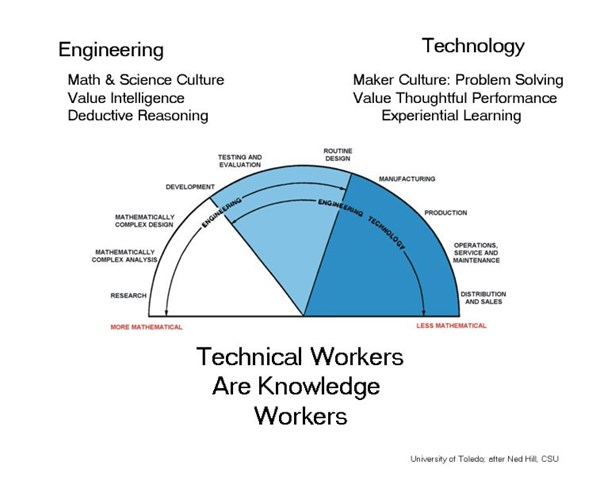A 4-Year Degree isn’t Necessary to Excel in this Field
The majority of the demand for skilled workforce in industry is in this area of engineering and production technology, requiring some post high school education or credential, but less than a 4-year bachelor’s degree.
The majority of the demand for skilled workforce in industry is in this area of engineering and production technology, requiring some post high school education or credential, but less than a 4-year bachelor’s degree.
The University of Toledo Engineering Department has a great graphic that shows where various jobs fit on the “knowledge worker” spectrum based on need for mathematical skills. We have added some additional thinking about “where the jobs are and what they demand.”

The occupations on the right side of the diagram demand less mathematics for daily work. These include:
- Distribution and sales would require counts and arithmetic to balance quantities, and sales orders and payment.
- Operations, service and maintenance positions would typically use numbers to look up and specify parts, measurements for fits, and evaluate process inputs and outputs.
- Production positions would use gages and hand-held measuring instruments as well as data from sensors to determine conformance to tolerances and to plot statistical control charts.
- Senior manufacturing positions would take this a step further to determine offsets and “true positions.”
- Testing and evaluation and quality control works almost exclusively with numeric data and uses coordinate measuring machines, optical comparators and gage blocks to determine conformance to print and capability of process.
The far right of the diagram’s dark blue portion corresponds to high school math, including algebra; more to the left the positions demand ability to use geometry and trigonometry. The production and manufacturing portions are typically best fit for persons with a 1-year credential such as a CNC operator certificate, various NIMS credentials, or 2-year associate degrees in various technology fields.
The left most portion of the light blue section is the realm of 4-year degree engineers and technologists and specialists (mechanical engineers, metallurgists, tooling engineers, chemists).
The white area on the left typically are positions filled by Master’s and Ph.D. level grads.
The majority of job openings in advanced manufacturing today require some post high school skilled training, but do not require a 4-year degree.
Technical workers are knowledge workers, and they are in high demand.
Originally posted at PMPAspeakingofprecision.com blog.









.jpg;maxWidth=300;quality=90)





